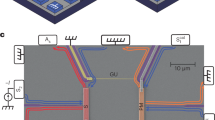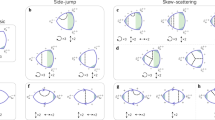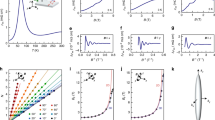Abstract
Topological states of matter are characterized by topological invariants, which are physical quantities whose values are quantized and do not depend on the details of the system (such as its shape, size and impurities). Of these quantities, the easiest to probe is the electrical Hall conductance, and fractional values (in units of e2/h, where e is the electronic charge and h is the Planck constant) of this quantity attest to topologically ordered states, which carry quasiparticles with fractional charge and anyonic statistics. Another topological invariant is the thermal Hall conductance, which is harder to measure. For the quantized thermal Hall conductance, a fractional value in units of κ0 (κ0 = π2kB2/(3h), where kB is the Boltzmann constant) proves that the state of matter is non-Abelian. Such non-Abelian states lead to ground-state degeneracy and perform topological unitary transformations when braided, which can be useful for topological quantum computation. Here we report measurements of the thermal Hall conductance of several quantum Hall states in the first excited Landau level and find that the thermal Hall conductance of the 5/2 state is compatible with a half-integer value of 2.5κ0, demonstrating its non-Abelian nature.
This is a preview of subscription content, access via your institution
Access options
Access Nature and 54 other Nature Portfolio journals
Get Nature+, our best-value online-access subscription
$29.99 / 30 days
cancel any time
Subscribe to this journal
Receive 51 print issues and online access
$199.00 per year
only $3.90 per issue
Buy this article
- Purchase on Springer Link
- Instant access to full article PDF
Prices may be subject to local taxes which are calculated during checkout





Similar content being viewed by others
Change history
14 August 2018
In this Article, the publication details for references 33, 34 and 40 have been corrected online.
References
Nayak, C. et al. Non-Abelian anyons and topological quantum computation. Rev. Mod. Phys. 80, 1083–1159 (2008).
Willett, R. et al. Observation of an even-denominator quantum number in the fractional quantum Hall effect. Phys. Rev. Lett. 59, 1776–1779 (1987).
Moore, G. et al. Nonabelions in the fractional quantum Hall effect. Nucl. Phys. B 360, 362–396 (1991).
Greiter, M. et al. Paired Hall state at half filling. Phys. Rev. Lett. 66, 3205–3208 (1991).
Read, N. et al. Paired states of fermions in two dimensions with breaking of parity and time-reversal symmetries and the fractional quantum Hall effect. Phys. Rev. B 61, 10267–10297 (2000).
Dolev, M. et al. Observation of quarter of an electron charge at the ν = 5/2 quantum Hall state. Nature 452, 829–834 (2008).
Radu, I. P. et al. Quasi-particle properties from tunneling in the ν = 5/2 fractional quantum Hall state. Science 320, 899–902 (2008).
Bid, A. et al. Observation of neutral modes in the fractional quantum Hall regime. Nature 466, 585–590 (2010).
Morf, R. H. Transition from quantum Hall to compressible states in the second Landau level: new light on the ν = 5/2 enigma. Phys. Rev. Lett. 80, 1505–1508 (1998).
Storni, M. et al. Fractional quantum Hall state at ν = 5/2 and the Moore–Read Pfaffian. Phys. Rev. Lett. 104, 076803 (2010).
Rezayi, E. H. Landau level mixing and the ground state of the ν = 5/2 quantum Hall effect. Phys. Rev. Lett. 119, 026801 (2017).
Levin, M. et al. Particle-hole symmetry and the Pfaffian state. Phys. Rev. Lett. 99, 236806 (2007).
Lee, S. S. et al. Particle–hole symmetry and the ν = 5/2 quantum Hall state. Phys. Rev. Lett. 99, 236807 (2007).
Wen, X. G. Non-Abelian statistics in the fractional quantum Hall states. Phys. Rev. Lett. 66, 802–805 (1991).
Halperin, B. I. Theory of the quantized Hall conductance. Helv. Phys. Acta 56, 75–102 (1983).
Yang, G. et al. Influence of device geometry on tunneling in ν = 5/2 quantum Hall liquid. Phys. Rev. B 88, 085317 (2013).
Yang, G. et al. Experimental constraints and a possible quantum Hall state at ν = 5/2. Phys. Rev. B 90, 161306 (2014).
Son, D. T. Is the composite fermion a Dirac particle? Phys. Rev. X 5, 031027 (2015).
Zucker, P. T. et al. Stabilization of the particle–hole Pfaffian order by Landau-level mixing and impurities that break particle–hole symmetry. Phys. Rev. Lett. 117, 096802 (2016).
Fidkowski, L. et al. Non-Abelian topological order on the surface of a 3D topological superconductor from an exactly solved model. Phys. Rev. X 3, 041016 (2013).
Bonderson, P. et al. A time-reversal invariant topological phase at the surface of a 3D topological insulator. J. Stat. Mech. 2013, P09016 (2013).
Kane, C. L. et al. Pairing in Luttinger liquids and quantum Hall states. Phys. Rev. X 7, 031009 (2017).
Schwab, K. et al. Measurement of the quantum of thermal conductance. Nature 404, 974–977 (2000).
Meschke, M. et al. Single-mode heat conduction by photons. Nature 444, 187–190 (2006).
Jezouin, S. et al. Quantum limit of heat flow across a single electronic channel. Science 342, 601–604 (2013).
Banerjee, M. et al. Observed quantization of anionic heat flow. Nature 545, 75–79 (2017).
Wen, X. G. Quantum Field Theory of Many-body Systems: From the Origin of Sound to an Origin of Light and Electrons (Oxford Univ. Press, Oxford, 2004).
Wellstood, F. C. et al. Hot-electron effects in metals. Phys. Rev. B 49, 5942–5955 (1994).
Umansky, V. et al. in Molecular Beam Epitaxy: From Research to Mass Production (ed. Henini, M.) 121–137 (Elsevier, Amsterdam, 2013).
Mooney, P. M. Deep donor levels (DX centers) in III–V semiconductors. J. Appl. Phys. 67, R1–R26 (1990).
Dolev, M. et al. Characterizing neutral modes of fractional states in the second Landau level. Phys. Rev. Lett. 107, 036805 (2011).
Jain, J. K. Composite Fermions (Cambridge Univ. Press, Cambridge, 2007).
Read, N. & Rezayi, E. Beyond paired quantum Hall states: parafermions and incompressible states in the first excited Landau level. Phys. Rev. B 59, 8084–8092 (1999).
Bonderson, P. & Slingerland, J. K. Fractional quantum Hall hierarchy and the second Landau level. Phys. Rev. B 78, 125323 (2008).
Dolev, M. et al. Dependence of the tunneling quasiparticle charge determined via shot noise measurements on the tunneling barrier and energetics. Phys. Rev. B 81, 161303 (2010).
Kane, C. L. et al. Quantized thermal transport in the fractional quantum Hall effect. Phys. Rev. B 55, 15832–15837 (1997).
Mross, D. F. et al. Theory of disorder-induced half-integer thermal Hall conductance. Preprint at https://arxiv.org/abs/1711.06278 (2017).
Wang, C., Vishwanath, A. & Halperin, B. I. Topological order from disorder and the quantized Hall thermal metal: possible applications to the ν = 5/2 state. Preprint at https://arxiv.org/abs/1711.11557 (2017).
Lian, B. et al. Theory of disordered ν = 5/2 quantum thermal Hall state: emergent symmetry and phase diagram. Phys. Rev. B 97, 165124 (2018).
Simon, S. H. On the interpretation of thermal conductance of the ν = 5/2 edge. Phys. Rev. B 97, 121406 (2018).
Willett, R. L. The quantum Hall effect at 5/2 filling factor. Rep. Prog. Phys. 76, 076501 (2013).
Samani, M. et al. Low-temperature illumination and annealing of ultrahigh quality quantum wells. Phys. Rev. B 90, 121405 (2014).
Rössler, C. et al. Gating of high-mobility two-dimensional electron gases in GaAs/AlGaAs heterostructures. New J. Phys. 12, 043007 (2010).
Slobodeniuk, A. O. et al. Equilibration of quantum Hall edge states by an Ohmic contact. Phys. Rev. B 88, 165307 (2013).
Dahlem, F. Cryogenic scanning force microscopy of quantum Hall samples: adiabatic transport originating in anisotropic depletion at contact interfaces. Phys. Rev. B 82, 121305 (2010).
Gelfand, B. Y. et al. Edge electrostatics and a mesa-etched sample and edge-state-to-bulk scattering rate in the fractional quantum Hall regime. Phys. Rev. B 49, 1862–1866 (1994).
Acknowledgements
We acknowledge B. Halperin and S. Simon for discussions. M.B. acknowledges the help and advice of Y. Gross regarding fabrication processes and R. Bhattacharyya for help with the cold amplifiers and Y. C. Chung and H. K. Choi for their help with the dilution refrigerator. M.H. acknowledges the continuous support of the Sub-Micron Center staff, and in particular Y. Rotblat, without whom this work would not be possible. M.H. acknowledges the support of the European Research Council under the European Community’s Seventh Framework Program (FP7/2007-2013)/ERC under grant agreement number 339070, the partial support of the Minerva foundation under grant number 711752, the Israeli Science Foundation ISF under grant number 459/16 and, together with V.U., the German Israeli Foundation (GIF) under grant number I-1241-303.10/2014. A.S and Y.O. acknowledge support from the European Research Council under the European Union’s Seventh Framework Program (FP7/2007-2013)/ERC Project MUNATOP, the DFG (CRC/Transregi 183, EI 519/7-1) and the Israel Science Foundation. Y.O. acknowledges the Binational Science Foundation (BSF). D.E.F.’s research was supported in part by the National Science Foundation under grant number DMR-1607451.
Reviewer information
Nature thanks K. Shtengel, S. Simon and the other anonymous reviewer(s) for their contribution to the peer review of this work.
Author information
Authors and Affiliations
Contributions
M.B. and M.H. designed the experiment, preformed the measurements, did the analysis and guided the experimental work. M.B. fabricated the devices with input from M.H., D.E.F. and Y.O., and A.S. worked on the theoretical aspects. V.U. grew the two-dimensional electron-gas heterostructures. All authors contributed to the write up of the manuscript.
Corresponding author
Ethics declarations
Competing interests
The authors declare no competing interests.
Additional information
Publisher’s note: Springer Nature remains neutral with regard to jurisdictional claims in published maps and institutional affiliations.
Extended data figures and tables
Extended Data Fig. 1 Details of the growth structure.
Schematic of the conduction band in the MBE-grown structures that were studied. The SPSL doping scheme comprises δ–Si doping planes placed in narrow GaAs quantum wells (QW). The thickness of the GaAs and AlAs quantum wells in SPSL is chosen in such a way that the X-band minima of the AlAs layers reside below the Γ-band minimum of the GaAs. Electrons that spill over to the AlAs wells have low mobility and thus do not participate effectively in the conduction process. This structure suffers from substantial added bulk heat conductance. The structure used in our study, with δ–Si doping in low-Al-mole-fraction AlGaAs, did not have a visible bulk thermal conductance.
Extended Data Fig. 2 Longitudinal resistance of the high-mobility SPSL-grown heterostructure.
Longitudinal resistance measured in a Hall bar 100 µm wide and 200 µm long. Fractional filling factors are more pronounced than in the δ–Si-doped structure. Yet, the structure suffers from added thermal conductance in the bulk (see main text).
Extended Data Fig. 3 Thermal noise analysis at ν = 2 in the bulk in the high-mobility SPSL structure.
Dissipated power in the floating reservoir is plotted as a function of Tm for different numbers of open arms, N, with one edge mode allowed to flow in each arm (controlled by the surface gates). Dashed curves show the one-parameter fit of α from ΔP(ακ0T2, βT5) for a given β (the value deduced from all the experiments). The apparent total thermal conductance is K = 7.34κ0 at N = 4 instead of K = 4κ0, and K = 5.33κ0 at N = 2 instead of K = 2κ0. The inset shows the dissipated power obtained when subtracting the contributions of a different number of open arms; this cancels the added phonons and bulk contributions, both of which depend only on Tm. The fit line leads to the average thermal conductance per channel gQ = (1.03 ± 0.04)κ0T, which agrees with the expectations. (Errors mentioned here correspond to a confidence level of better than 95%.) This device was not used in the experiments.
Extended Data Fig. 4 Equal branching of current in all arms at ν = 5/2.
Current is sourced from the source, S, and measured in the drain, D, in the same arm (see Fig. 1a). The blue curve shows the reflection coefficient of the current measured in the drain as a function of the pinching of the arm gate. The reflection coefficient value starts from 0.25, when all the arm gates are fully open, and reaches 1.00, when all the current is reflected. The red, green and magenta curves correspond to measurements for the fully open ‘measurement arm’, performed while the other arm gates deplete gradually one by one. Four open arms give a reflection coefficient of r = 0.25, whereas three open arms lead to r = 0.33 and two open arms give r = 0.50. The dotted lines are guides for the eyes indicating equal branching of currents.
Extended Data Fig. 5 Thermal noise analysis at ν = 7/3 and ν = 8/3.
a, b, Standard analysis (see main text), without subtracting the number of participating arms, but using the phonon contribution coefficient β, which fits extremely well in a large range of temperatures and at different filling factors (errors of the fit are 99% confidence levels). The agreement with the expected data is clear. We note the added thermal heat conductance at ν = 8/3 (b; see text).
Extended Data Fig. 6 Upstream neutral modes in ν = 5/2 and ν = 8/3.
a, b, The noise measured at an upstream floating contact connected to the cold amplifier (with respect to ground) is clear evidence of upstream neutral modes. Such upstream noise is not found in particle-like states21.
Rights and permissions
About this article
Cite this article
Banerjee, M., Heiblum, M., Umansky, V. et al. Observation of half-integer thermal Hall conductance. Nature 559, 205–210 (2018). https://doi.org/10.1038/s41586-018-0184-1
Received:
Accepted:
Published:
Issue Date:
DOI: https://doi.org/10.1038/s41586-018-0184-1
This article is cited by
-
Non-Abelian topological order and anyons on a trapped-ion processor
Nature (2024)
-
Heat conductance of the quantum Hall bulk
Nature (2024)
-
Direct determination of the topological thermal conductance via local power measurement
Nature Physics (2023)
-
Large composite fermion effective mass at filling factor 5/2
Nature Communications (2023)
-
Nanoscale electrostatic control in ultraclean van der Waals heterostructures by local anodic oxidation of graphite gates
Nature Physics (2023)
Comments
By submitting a comment you agree to abide by our Terms and Community Guidelines. If you find something abusive or that does not comply with our terms or guidelines please flag it as inappropriate.



